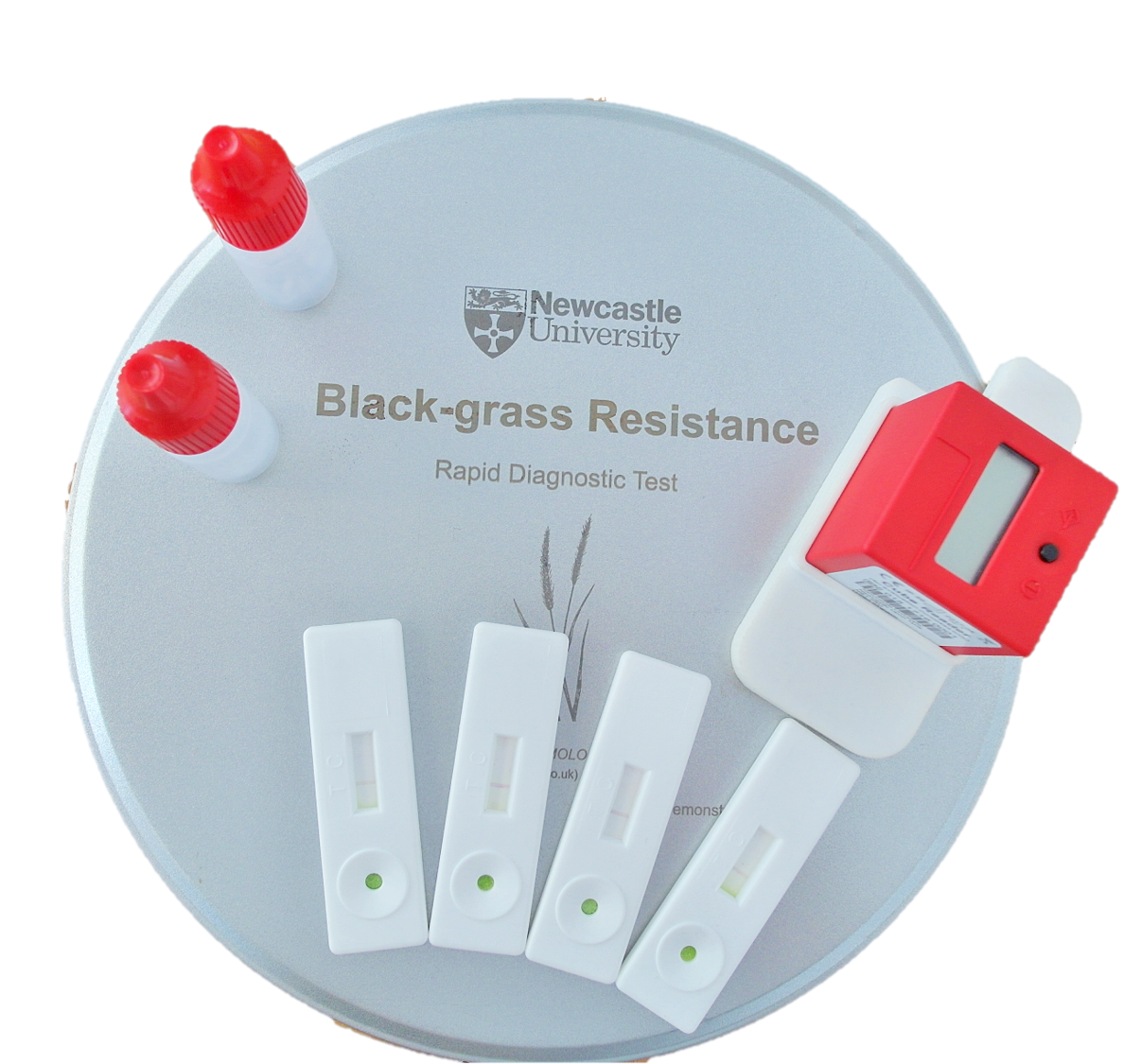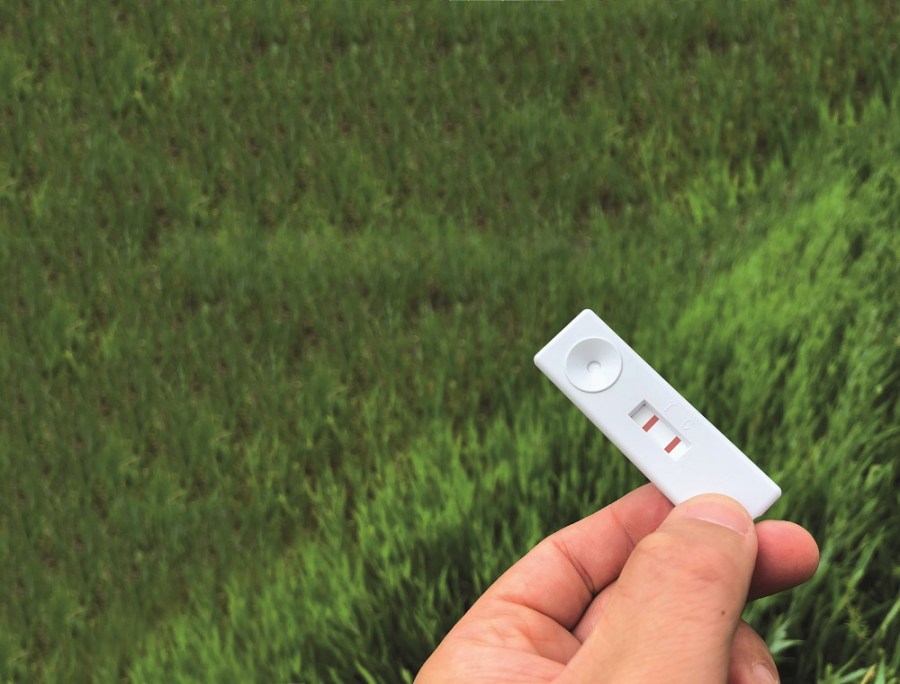An in-field test for non-target site resistance in blackgrass has become available this autumn. CPM finds out more about BReD and asks how it can help manage resistant blackgrass populations.
For many years medicine has been using diagnostics at the point of care and this is what we’re bringing into agriculture.
By Lucy de la Pasture
For growers with a blackgrass problem, there’s an odds-on chance they have resistance in one or all of its many guises, says independent weed scientist Dr Stephen Moss. It may be target-site resistance or one of a number of mechanisms that fall under the umbrella of non-target site resistance (NTSR).
Of the two types of resistance, NTSR is the more insidious and less well understood. “It’s difficult to predict which herbicides may be affected when NTSR is a factor,” he explains.
“Resistant blackgrass is almost everywhere in the UK. With target site resistance it tends to be a ‘black and white’ situation, so it’s relatively easier to make better management decisions than with NTSR, which will vary from farm to farm and, in all likelihood, a whole range of different herbicides will be affected to different degrees.”
Although there are several different mechanisms of NTSR, the most widespread is enhanced metabolic resistance (EMR), which is where blackgrass plants have developed mechanisms which give them an enhanced ability to detoxify herbicides.

The Mologic BReD diagnostic kit can be interpreted by inserting the device into ‘The Cube’ reader (top right).
In the field, difficult to control blackgrass is often a complex soup of resistance mechanisms, and research on resistance testing (Hull et al, 2014) estimated that nearly half of the UK blackgrass population has multiple resistance to three different modes of action (MoA).
In these tests, 98% showed resistance to at least one herbicide, with 75% resistant to mesosulfuron+ iodosulfuron (Atlantis), 84% resistant to cycloxydim (Laser) and 66% resistant to pendimethalin.
In the past, resistance testing has mostly relied on testing blackgrass seeds collected in the field and pot-testing the seedlings using a range of indicator herbicides. Pot tests are able to pick up resistance regardless of the mechanisms, but results aren’t generally available until Christmas which is too late to influence autumn herbicide decisions, explains Stephen.
“Pot tests may be slow but they’re the only test that mimics what is actually happening in the field by growing the plant and spraying with a herbicide. The results give a good idea of the degree of resistance in general, but some interpretation on the likely mechanism of resistance may be possible. If there’s a positive for cycloxydim then resistance is likely to be target site as there’s no evidence of EMR occurring with cycloxydim. Clodinafop on the other hand is vulnerable to both types of resistances,” he explains.
Faster alternatives include the Rothamsted Rapid Resistance Petri-dish Test and genetic testing using blackgrass shoots, both of which have the advantage of being quicker and potentially giving a better indication of the resistance mechanisms present.
For the first time, an in-field test is available this autumn and will provide an instant result on the presence of NTSR in blackgrass. Funded by BBSRC and AHDB, the underpinning science for the new blackgrass resistance diagnostics tool (BReD) has been developed by scientists at Newcastle University as part of the Blackgrass Resistance Initiative (BGRI), a partnership with Rothamsted Research, Sheffield and York Universities and the Institute of Zoology.
The test is available from commercial partner Mologic, a medical diagnostics specialist who have brought their expertise to the table and worked in collaboration to develop the test.

A total of 122 non-random populations, collected in 2013, were tested on assays with 3 herbicides -mesosulfuron+ iodosulfuron, pendimethalin and cycloxydim.
Source: Hull, R & Tatnell, Lynn & Cook, Sarah & Beffa, R & Moss, S.R. (2014). Current status of herbicide-resistant weeds in the UK. Aspects of Applied Biology. 127. 261-272.
“Early-indication diagnostic tests are common place in medicine, such as for pregnancy or diabetes, and are used to help people make decisions much earlier on with the aim of improving the long-term outcome. It should be no different in agriculture,” says Prof Robert Edwards, head of Agriculture at Newcastle University.
“Blackgrass resistance is creeping up the country and our first line of defence – herbicides – are becoming less effective, just like antibiotics in medicine,” he explains. “And just like in medicine where researchers and clinicians are working side-by-side to come up with new solutions, in agriculture we need to be doing the same.
“For many years medicine has been using diagnostics at the point of care and this is what we’re bringing into agriculture with the BReD test.”
The innovative test uses a lateral flow device, which looks and works in the same way as a pregnancy test by detecting an elevated level of a marker protein and producing a red-line to indicate a positive result.
The marker in this case is a specific protein called glutathione transferase ‘AmGSTF1’, which has been identified by Prof Robert Edwards’ research group at Newcastle University. “This specific protein is elevated in all NTSR populations of blackgrass identified to date and we’re very confident the test will pick up any form of NTSR in blackgrass populations,” he comments.
The assay used in the test to detect NTSR is a world-first and it marks the beginning of on-farm diagnostics being affordable and available, he comments. The concentrations of AmGSTF1 in blackgrass can be used to assess the level of herbicide resistance exhibited in NTSR populations. The more protein it detects, the more resistant the blackgrass and the stronger the red line produced in the test, explains Robert.
Frontier have been trialling the test in the field for the past two seasons and found it to be straightforward to use in practice and relevant at all growth stages of the blackgrass plant, says technical manager Christine Lilly. “We tested BReD with agronomists in different geographical areas and found we had a wide range of results, from sensitive populations to Peldon levels of resistance.”
The tests were sent to Newcastle University so they could compare Frontier’s results to blackgrass populations of known resistance to give a quantitative interpretation, says Christine. “As it stands the test gives a positive or negative for NTSR, with the strength of the positive result indicated by the depth of colour of the line in the test window.
“But the result can be given a numerical value by inserting into a device known as ‘The Cube’ and this is how the University compared our samples to give us a better indication of the level of resistance present.”
The Cube reader is available to buy from Mologic, adds Robert. “When we trialled the tests this summer, growers and agronomists liked having the reader to use. Some larger farms have already bought their own reader for a few hundred pounds but we’re also in discussion with the NFU and AHDB about making readers available at regional centres so all growers can have access to one.”
A banded colour card, similar to those used in pH tests, is also in the pipeline to enable testers to easily gauge the strength of a positive result, he says.
Robert believes the new diagnostic test gives just a glimpse of how diagnostics will help growers in the future and acknowledges the fact that it doesn’t tell the whole story where blackgrass is concerned but he believes it can be used as a management tool.
“There are multiple types of blackgrass resistance present and these are very population specific. You may have a population in Suffolk with NTSR that can detoxify Atlantis (mesosulfuron+ iodosulfuron) but is still susceptible to ACC-ase herbicides and the opposite may occur in another blackgrass population nearby.
“The BReD test won’t tell you which herbicide to use but it does prove when you have a NTSR problem and any poor control of blackgrass isn’t just down to application or conditions. The test can also be used to monitor whether the measures being used on the farm to manage resistance are actually being effective. Those are things we’ve found growers say they’d find really useful.”
Christine agrees one of the major benefits of the test is to monitor changes in EMR, particularly when assessing the effect of a change in management or cultivation practice. “Deep cultivations may have brought up blackgrass seed from deeper in the soil profile and this may have a completely different resistance profile to the previous population of blackgrass.
“In a year where herbicides don’t work very well, the test would also be useful to help pinpoint whether this was due to resistance, which is often assumed, or something else,” she says.
The new test is of particular interest in parts of the world where blackgrass resistance is an emerging problem. In these situations, it can be used to pick up NTSR early enough in its development to put an anti-resistance strategy firmly in place before the problem becomes widespread, says Robert.
BReD testing in the UK has also revealed blackgrass populations in Dorset with extremely low levels of NTSR, indicating the problem is emerging as populations evolve in that region, he adds.
There’s already been interest in the test from other countries, he confirms. “We can adapt the assay to test for NTSR in other grass species, such as ryegrass, wild oats and brome because the same protein becomes elevated when resistance is present. It’s generating a lot of interest from the USA and Australia where resistant ryegrass is a problem,” he explains.
So what does the future hold for on-farm diagnostics? A second-generation test is under development that will be able to identify the different types of NTSR present in a sample. “We’re looking at a second group of proteins which have different patterns of expression depending on the resistance type,” he explains.
This step forward in on-farm diagnostics would give growers the capability to make more informed decisions regarding herbicides. A second prong of research is developing molecular markers for target site resistance, so when used in conjunction, the whole range of resistance types will become detectable using in-field testing, explains Robert.
New Atlantis formulation boosts activity
This autumn Bayer is launching Atlantis OD (oil dispersion) as a replacement for Atlantis WG (water dispersible granules). The two products have the same active substances delivered at the same rate – mesosulfuron 12g/ha and iodosulfuron 2.4g/ha – the difference is in the formulation, with the new formulation offering an improvement in performance.
“Despite having the same active ingredients, in trials Atlantis OD has been shown to have a clear advantage over Atlantis WG for control of blackgrass,” says Bayer’s Dr Gordon Anderson Taylor. “The OD formulation improves the active ingredients’ penetration into the leaf, maximising biological activity of the active chemicals, resulting in better control.”
In 16 trials from 2015–2018, Atlantis OD showed a significant 6% improvement over Atlantis WG in overall blackgrass control. Although, it might seem like a modest increase, small differences add up over the entire blackgrass control programme, says Gordon.
It’s thought the difference in control is due to the presence of enhanced metabolic resistance in the population, he explains. By delivering the active more effectively, the OD formulation can overcome this resistance mechanism to a greater extent and offer improved control.
When Bayer first started testing WG and OD formulations over a decade ago there was no significant difference between the two forms of Atlantis. In recent years, the situation has changed with the 6% difference now apparent.
To maximise the effects of Atlantis OD on weed populations, Gordon recommends applying early in the season when the target weed is small and actively growing.




